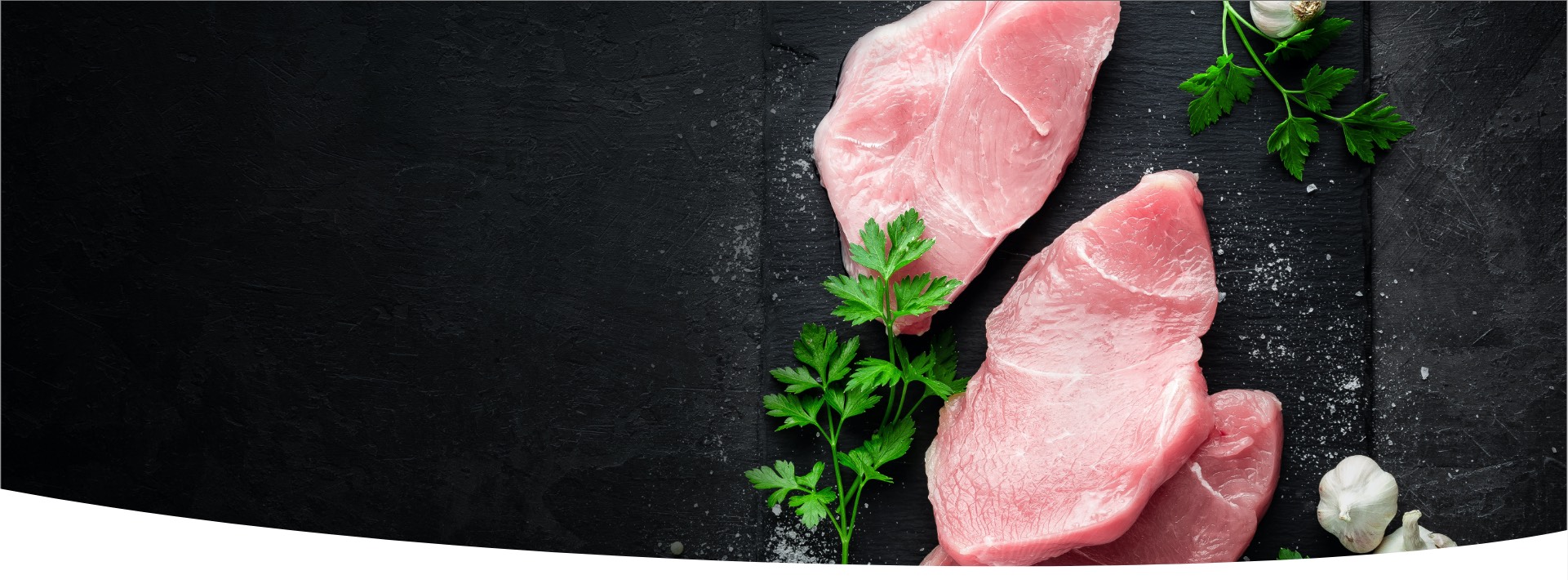
Frequently Asked Questions

The European Union policy assumes that livestock has guaranteed five fundamental freedoms:
- freedom from hunger, thirst and malnutrition by providing access to fresh water and food to keep animals healthy and strong;
- freedom from mental injury and pain by providing adequate shelter and resting places;
- freedom from pain, wounds and illness through prevention, rapid diagnosis and treatment;
- freedom to express natural behaviour through provision of adequate space, conditions and company for other animals of the same species;
- freedom from fear and stress through provision of care and treatment that does not cause psychological suffering to animals.
These freedoms are an absolute basis for the functioning of animal welfare in the European Union. For the law to be respected, cross-compliance requirements are in place in the EU, as a result of which every farmer in the EU has to meet at least the same standards as those required by EU legislation. As a result, the EU has some of the highest production welfare standards in the world.
The implementation of the 5 freedoms is based on many restrictive control instruments. There is no room for deviations from the welfare standards that have been adopted for the whole common market. The effectiveness of this system is confirmed by audits by the European Court of Auditors, which, following comprehensive audits of animal welfare control bodies in the EU countries, not only has not found significant irregularities but also appreciated a number of new initiatives, such as the introduction of group housing for gestating sows[1].
The European Union is one of the largest pork manufacturers in the world with its 23 million tonnes of pork in 2020; this makes it the second largest manufacturer in the world, after China (43 million tonnes) and before the United States (12 million tonnes)[1].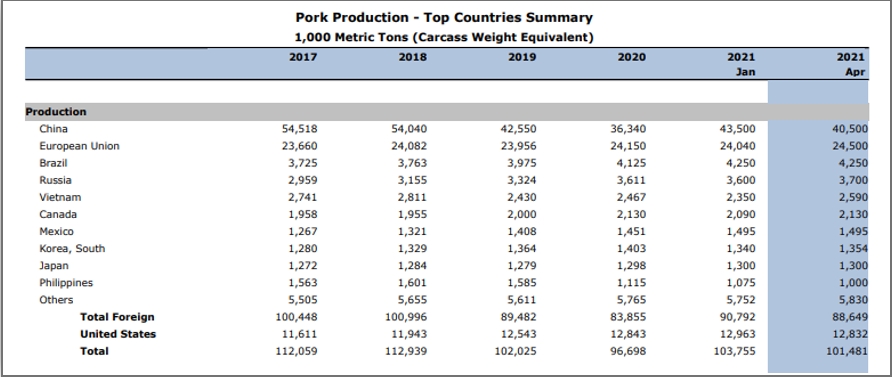
The European Union is the world’s third largest provider of beef (after the USA and Brazil), accounting for around 13% of world production. It is one of the leaders along with such countries as Brazil, the United States, China, India, and Argentina[2].
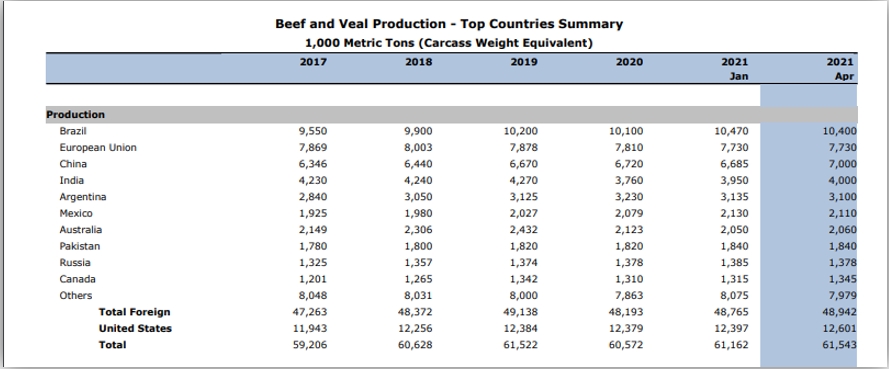
- [1] https://ec.europa.eu/agriculture/sites/agriculture/files/market-observatory/meat/pigmeat/doc/dashboard-pig_en.pdf
- [2] https://apps.fas.usda.gov/psdonline/circulars/livestock_poultry.pdf
According to Eurostat estimates, in 2020 beef exports increased by 3% to 491 thousand tonnes. Pork exports increased by as much as 19%, reaching 5.4 million tonnes, which allowed the EU to maintain its leading position in the global red meat exports.
Beef from the European Union is shipped to many destinations. The main recipients of beef (HS Code 0202) are:
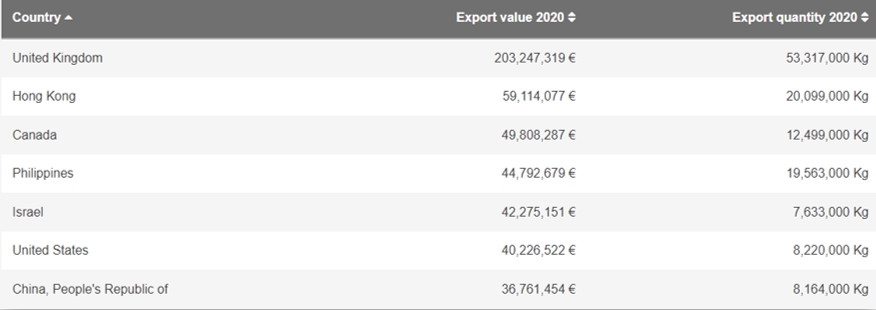
Pork (HS Code 0203) is shipped to:
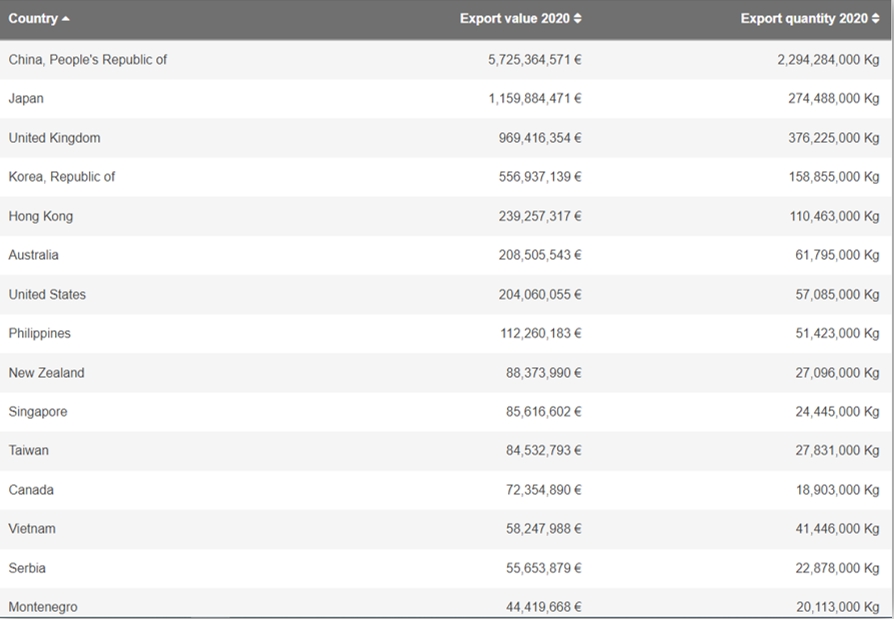
- [1] https://ec.europa.eu/info/sites/default/files/food-farming-fisheries/farming/documents/beef-veal-market-situation_en.pdf
The quality of meat produced in the European Union is determined by high production and animal welfare standards, reduced use of antibiotics, ban on the use of growth hormones in meat production and ban on the use of hormones and antibiotics in feed. The high transparency of meat production, in line with the “from farm to fork” principle, is also important. High standards are maintained everywhere regardless of the region of the European Union – under cross-compliance requirements, every farmer in the European Union has to produce food according to strict regulations resulting from the relevant legislation. Under these regulations, every farmer involved in livestock production in the EU is obliged to:
- keep animals in conditions that do not cause injury or suffering;
- ensure that animals are cared for by a sufficient number of staff with appropriate competences and professional qualifications;
- provide appropriate lighting, adapted to the animals’ needs;
- provide proper care for sick animals and to call a vet when the situation requires it;
- precisely document all livestock production and movements;
- provide protection from the weather;
- ensure that persons looking after the animals do not cause them pain.
Red meat production in the European Union is characterised by a large number of cooperatives and family farms. There are large production companies and corporations, but family farms form the foundation of agriculture in the European Union.[1] These farms serve a dual function: they not only produce healthy food, but also provide a livelihood for a wide range of European farmers. As a result, farms in Europe are strongly committed to long-term, sustainable development that takes into account the future of children and successors who take over the farms handed down from one generation to another. It is not just a desire for short-term profit, as is the case with huge players in other parts of the world.
A good example is pork production in Denmark. Over there, the basis for production are large, specialised, multi-generation farms. However, they do not operate alone – practically every farmer is a member of some branch association. The largest slaughterhouse and processing plant, with a 94% share of the Danish market, is a cooperative of over 7,000 farmers[2]. Such activity stabilises the sector – in case of lower livestock prices, farmers receive an appropriate slaughter dividend. Having a share in other stages of production ensures high standards – the farmer produces raw material of the best quality to achieve proper profitability at later stages of production.
The European Union is a leader in sustainable production and combating climate change. This also applies to food production and, in particular, meat production, so that solutions to reduce the environmental impact of the meat industry are widely used. An example at the start of the value chain is the Nitrates Directive[1] – European livestock farmers need to demonstrate precisely what happens to animal by-products and whether the amount of manure does not exceed environmentally-friendly standards. Farmers in Europe also take care to protect genetic resources and preserve the environment. There are a number of aid schemes in place in the EU to support the rearing of endangered breeds and the grazing of animals in ecosystems that would decline after withdrawal of livestock.
With the implementation of the European Green Deal, further solutions will be introduced to make meat production even greener. The amount of water used in technological processes and non-renewable materials in packaging is expected to be significantly reduced. It should also be noted that meat processing in the EU makes intensive use of green energy. This sector is not only a recipient of electricity, but also of heat and steam produced by cogeneration. More and more short energy supply chains for meat production are emerging in Europe[2]. This is a continuation of the current trend, with more than 11,000 agricultural biogas plants built between 2009 and 2017 in 7 years[3].
Meat products from the European Union enjoy an excellent reputation all over the world. Europe is a world leader in the production of high quality cold cuts and preserves. The rich tradition of sausage making is also very important – German frankfurters, Spanish chorizo, Italian salami, Lithuanian kindziuk and Polish kabanos are unique on the global scale. Excellent reputation is also enjoyed by long-aged hams from southern European countries – jamon serrano, Parma ham and German Black Forest ham. These are names and flavours recognized all over the world, unequivocally associated with unique taste sensations. In addition to the excellent quality guaranteed by the EU system of protection of regional and traditional products, these products have a very long history and the rules have been passed on from one generation to another for many years. Due to such a rich tradition of food production, European cuisine offers a great number of different kinds of a very good quality meat products.
In the times of growing popularity of products that do not require processing before consumption, EU meat products are a great choice – they do not require much preparation, are nutritious, have a good natural composition and are very tasty.
The rules on the labelling of meat products in the European Union and America have many similarities and are aligned with international standards and thus similar in many respects. The same rules apply to the minimum font size for providing mandatory information, presentation of the list of allergens and the scope of the required nutritional values information.
There are, however, some differences which mean that the same information is presented differently. This concerns primarily the way in which producers provide calorific and other nutritional information to consumers. In the USA, labels must indicate the number of portions per packaging. Calorific value is stated for specific portions of the product, e.g. based on the number of slices of sausage in the packaging or the number of portions of a given dish. In the EU, all calorie lists are based on 100 g or ml of product. There are also differences in the indication of the salt content – in the EU the value is given in grams per 100 grams of product, while in the US the value is given in the amount of sodium in milligrams per portion.
Colourants and additives are also presented in different ways on both continents. In the EU, such information in usually provided with the use of relevant codes consisting of the letter E and specific digits. In the USA, additives of this type are indicated with full substance names.
If you are interested in buying wholesale quantities of meat from the European Union, please contact the Meat Importers Council of America based in Washington. This organisation can provide knowledge about the directions of meat imports to the United States and Canada and facilitate further contact with individual meat importers and exporters, including the campaign initiators, the Union of Meat Industry Producers and Employers. We also encourage you to contact us directly at info@meatfromeurope.eu. For retail shopping, use the labels. Products from the European Union have mandatory labelling on their packaging to indicate the producer, country of origin, product content and nutritional values, and are labelled according to US and Canadian regulations.
The US Food and Drug Administration website also lists food importers from each state. By following the list, you can contact the company of choice and ask about meat imported from the European Union.
Information about Canadian importers of European Union meat can be found in the government’s Canadian Importers Database by searching by the country of origin, product or importer address.
Useful links:
The European Union guarantees a number of food safety standards. Intensive control and strict regulations, including GMP (Good Manufacturing Practices), GAP (Good Agricultural Practice – for farming and ranching) and HACCP (Hazard Analysis and Critical Control Points)[1] are permanently embedded in European legislation. These requirements are commonly applied at every stage of the value chain. Each European Union country is also a member of the Codex Alimentarius, responsible for international standards in the food trade[2].
Compliance with those requirements makes it easy to find EU plants that are not only authorised to export to the United States but also have been additionally certified to fulfil the needs of private customers, such as processors, wholesalers and retail chains.
Examples include the International Food Standard (IFS) and the British Retail Consortium (BRC). Many companies also have ISO 9000 certificates for quality management[3]. It is worth stressing that private standards are based, inter alia, on the aforementioned elements required by European legislators. The best evidence of the attention paid to certification is the Global GAP system, where European entities represent as much as 58% of all entities certified in the Global GAP[4].
As a result of the prevailing COVID-19 pandemic, not later than in the first year of the campaign (May 2020 – April 2021), outbound events of economic and opinion-forming nature, including a visit of journalists and opinion leaders from the USA and Canada to Poland, a study visit of meat and meat-product importers from the USA and Canada to Poland, during which a seminar combined with B2B meetings was planned, have been suspended with the possibility of carrying out these activities in the consecutive year (May 2021 – April 2022). Despite new reality, it is still crucial to establish direct B2B contacts as part of business relations – especially those involving large-scale cooperation, such as food exports. Therefore, it is assumed that all planned events in line with the campaign can be held. In case of inability to travel or other difficulties preventing face-to-face meetings, we will consider arranging online meetings with the participation of UPEMI representatives and its members, which will be announced via the campaign’s website and social media channels.
Imports from the European Union to Canada require an import licence from the CFIA (Canadian Food Inspection Agency), which is valid for two years. The CFIA provides a few tools to facilitate imports, including a search engine for entities with a licence: https://inspection.gc.ca/webapps/foodlicenceregistry/en/
Another tool allows you to view lists of entities authorized to export meat to Canada from a specific country. This search engine is available at: http://www.inspection.gc.ca/active/netapp/meatforeign-viandeetranger/forliste.aspx
The USDA, the US Department of Agriculture, also provides several tools to help you find entities authorized to export meat. A list of facilities authorized to export is available at the link:
https://www.fsis.usda.gov/wps/portal/fsis/topics/international-affairs/importing-products/eligible-countries-products-foreign-establishments/eligible-foreign-establishments
Just click on a country to get a list of operators authorised to export meat products.
African Swine Fever in the European Union is controlled by means of several main measures: bio-insurance, regionalisation, and prevention, as well as education. Bio-assurance is based on limiting as much as possible the movement of the virus between facilities, regions, and countries within the European Union. A few instruments have been introduced in the EU to support the construction of fences, sanitary installations and infrastructure aimed at limiting the transmission of the virus both by animals and humans[1]. As part of the European Union’s actions, a division into different zones was introduced, the class of which depends on the type of events related to ASF. There are three classes of zones: I – the blue zone is a protective area, zone II – the pink zone is a restricted area due to the occurrence of ASF cases in wild boars while zone III – the red one is a risk area that refers to areas where there have been recent outbreaks of ASF in pigs. Accordingly, the flow of animals and meat is shaped in such a way that animals and meat from the highest risk zones do not reach areas not subject to restrictions and countries recognising regionalisation. As a preventive measure, farms in zones I-III are currently obliged to erect fences around buildings housing animals, maintenance feed and bedding and to take the highest possible hygiene measures.
Some countries also carry out regular preventive testing of animals for ASF to limit the transmission of the disease.
- [1] https://eur-lex.europa.eu/legal-content/PL/TXT/HTML/?uri=CELEX:32020R0687&from=EN